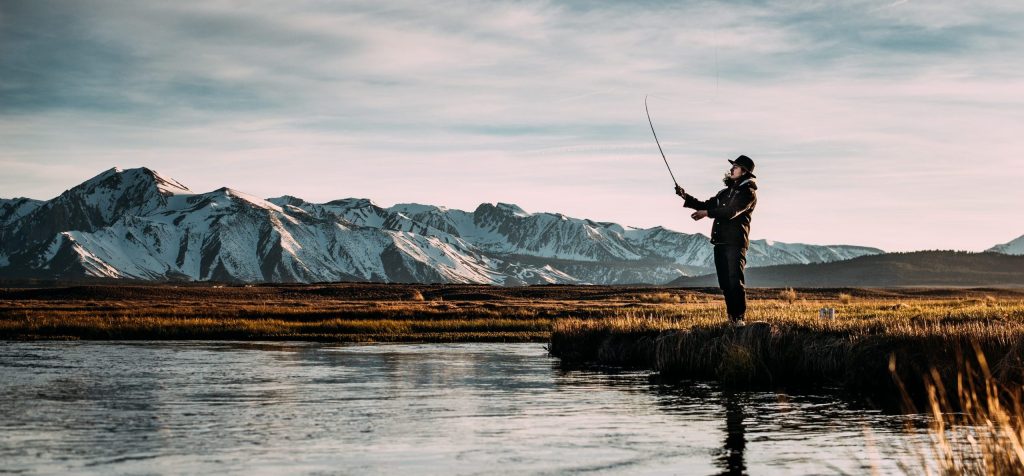Simplified Trout Fishing in New Zealand There’s no greater pleasure than experiencing New Zealand’s breathtaking outdoors while fishing for trout. With numerous fishing spots, you won’t have to venture far to find the perfect one.
Follow these 5 easy steps to get started:
1. Purchase your fishing license
Depending on how long your want to fish, there are fishing licences to suit, from a single day to all season long.
2. Choose a suitable fishing spot
With so many places in New Zealand to choose from, here are a couple of great spots available on OutdoorHQ
- Fairleigh Farm in Otago – The farm’s highlight is the Taieri River, granting exclusive access to a rarely frequented fishing location. Fishermen can find an abundance of Brown Trout, Sea Trout, and Perch in its waters. – Learn more about Farleigh Farm
- Station Peak in Canterbury – The property provides access to the Waitaki River a clear, braided river, where anglers can catch sizable Brown and Rainbow Trout, as well as Quinnat Salmon during certain times of the year – Learn more about Station Peak
3. Prepare your fishing gear
Improving the fundamental skills significantly raises the likelihood of achieving success
The spinning reel is a critical component of your fishing gear. Investing in a high-quality reel is recommended, but you don’t necessarily need to spend a fortune. Purchase the best one you can afford and choose between a right or left-hand wind model that feels most comfortable. A smooth operation, light weight, and large enough capacity to carry sufficient line are essential features of a good reel.
A two-meter-long rod designed to cast a lure weighing 7-10gms is ideal. Look for guides lined with ceramic instead of chromed wire to minimize line wear. The price of the rod varies depending on the material used, so it’s best to buy the best one you can afford.
A line with a breaking strain of 3-4kg is suitable for landing most fish in various conditions.
To prevent losing your main line when a lure gets irretrievably snagged, use a small spool of nylon with a slightly lower breaking strain than the primary line as a trace. A small swivel connects a short piece of this thinner line to the main line, preventing spinning lures from kinking the primary line. Tie the other end of the trace directly to the lure to avoid losing the main line.
4. Refine your fishing technique
Spin fishing is a technique used to catch trout with lures that mimic small fish. It is an excellent starting point for beginners, as the necessary skills are easy to learn. To give yourself a decent chance of catching trout, you only need a basic setup of a rod, reel, line, and a few lures.
The water knowledge and understanding of trout behavior gained from spin fishing provide an ideal foundation if you plan to try other fishing methods, such as fly-fishing or jigging from a boat.
Popular lures include a black and gold ‘toby’ or Rapala, while soft baits have recently gained popularity. To imitate a small swimming fish, a staple food for trout, lures are cast out and then retrieved.
5. Begin your fishing adventure!
A fishing license is necessary to go fishing, and there are nine different types available, ranging from a one-day pass to a whole year. Opting for a full-season license is the most cost-effective approach, as it enables you to fish at your convenience.
Ensure that you sign your license and always carry it with you while fishing. Abide by the rules and regulations and enjoy your time on the water.
Purchase fishing license


Looking for more to read?
SADDLE UP SAFELY: Riding Tips for Exploring the Farm
Aug
MASTERING HUNTING PHOTOGRAPHY: Tips, Gear, and Techniques
Jul
TOP 10 ESSENTIALS: Hunting Gear for the New Zealand outdoors
Jun
BEGINNER’S GUIDE: Downhill Mountain Biking in New Zealand
Jun
HORSE TREKKING ADVENTURE TO LOCKHARTS: Exploring Canterbury’s Private Land with OutdoorHQ
Jun
DISCOVER THE JOY OF TROUT FISHING: A COMPREHENSIVE GUIDE
May
TOP TIPS FOR COOKING IN A CAMPERVAN: NEW ZEALAND ROAD TRIP
May
HUNTING WITH KIDS IN NEW ZEALAND: 7 REASONS TO GIVE IT A TRY
May
EXPLORING THE BEAUTY OF FRESHWATER FISHING WITH OUTDOORHQ
May
NZ DUCK SHOOTING SEASON 2023: LICENSES, RULES, & BAG LIMITS
May
ENHANCE YOUR DUCK HUNTING: NEW ZEALAND 2023 SEASON TIPS
Apr
THE THRILL OF HORSE TREKKING IN NEW ZEALAND
Apr
THE PERKS OF PARKING YOUR CAMPERVAN ON PRIVATE LAND IN NEW ZEALAND
Mar
DISCOVER NEW ZEALAND’S HIDDEN TRAILS: MOUNTAIN BIKING ON PRIVATE FARMLAND
Mar
OFF THE BEATEN TRAIL: HORSE TREKKING ON PRIVATE FARMS IN NEW ZEALAND
Mar
HOW TO SAFELY HUNT FOR YOUR FIRST STAG
Mar
WHY LESS HUNTING ACCIDENTS HAPPEN ON PRIVATE LAND
Mar
DO THE RIGHT THING AND REDUCE HUNTING ACCIDENTS IN NZ
Mar
BE RESPECTFUL TO FARMERS THIS ROAR SEASON
Feb
GUIDE TO BAGGING A STAG THIS ROAR SEASON
Feb
THE BENEFIT OF HUNTING ON PRIVATE LAND DURING THE ROAR
Feb
INTRODUCTION TO THE ROAR SEASON IN NEW ZEALAND
Feb
PART II: LINBURN FARM STAY, A GIFT FROM GISBORNE
Jan
PART I: LINBURN FARM STAY, A GIFT FROM GISBORNE
Jan
PART II: HUNTING THE HAWKES BAY HIGHLANDS
Jan
PART I: HUNTING THE HAWKES BAY HIGHLANDS
Dec
FILL THE FREEZER…SHARE YOUR CATCH
Nov
WILD FOOD DEGUSTATION
Nov
THE WILD VENISON BANQUET
Nov
RAYONIER MATARIKI FORESTS – CASE STUDY
Oct
WELCOME TO BLUE MOUNTAINS HUNT BLOCK
Oct
HUNTING DOESN’T HAVE TO BE DIFFICULT
Sep
FILL THE FREEZER….FOR FREE!
Sep
THE REALITY OF PRODUCING WILD FOOD
Sep
TAKE A SEAT AT THE WILD TABLE
Sep
THE FISHING PAPER & HUNTING NEWS
Jun